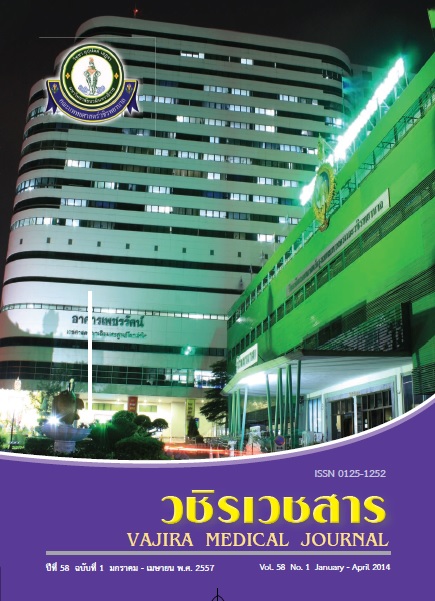Model Predicting Bone Marrow Infection as a Cause of Cytopenias in HIV Patients
Main Article Content
Abstract
Introduction: Cytopenias are common in HIV patients. They may be caused by multiple mechanisms including occult bone marrow infection (BMI). The objectives of this study were to describe the characteristics and clinical course of HIV patients with cytopenia and to create a predictive model of BMI for those patients in whom a bone marrow examination (BME) is warranted.
Method: Cases of HIV patients with cytopenias who had a BME at Chonburi Hospital from January 2005 to December 2009 were retrospectively reviewed. History of opportunistic infection (OI) and previous drugs taken, as well as patient characteristics such as fever, lymphadenopathy (LN) and hepatosplenomegaly (HS) were recorded. Laboratory result such as complete blood count, CD4 level, alkaline phosphatase (ALP) level and BME findings were obtained from their medical records. Natural history including survival was described. Logistic regression was used to establish a predictive model for decision about risk of BMI.
Result: Forty-three patients, predominately male (60.5%), were included in the study. The mean age of the subjects was 36.8 years (21-66). Most of the patients had symptomatic HIV and mean CD4 level was 67.4 cells/mm3 (0-604). Tuberculosis (TB) was the most common previous OI at 76.7%. Antiretroviral drugs were being taken by 34.9% of subjects. At the time of BME, 69.8% had fever and 58.3% had LN and/or HS. All the subjects had anemia and 46.5% had a low absolute neutrophil count. The mean ALP level was 271.5 IU/L (43-1173). A BME showing a myeloid:erythoid ratio greater than 3:1 was present in 47.4%. Plasmacytosis was seen in 91.4%, a left shift in the myeloid series in 75%and dysplastic cells in 40.5%. Only 8% had an absence of iron deposits on their BME. All of the stains and cultures for infection were negative. Most of the BME findings (65%) were nonspecific for any definite diagnosis. Of the 15 cases with a definite diagnosis by their pathologic finding, 46.7% had TB; the others were Pneumocystis jirovecii and histoplasmosis. The medial overall survival was 501 days. A concordance finding of LN and HS has a significantly negative impact to the patient’s survival. (p = 0.005) The predictive model was created.
Conclusion: Cytopenia in an HIV patient is the sign of more advanced disease. Organomegaly was found to be a significantly poor prognostic factor in these cases. Reactive BM and dysplastic features stated as unspecific BM were mostly found. True BMI was less. A predictive model was created to effectively determine suitable cases to have BMI. The limitation of this study was small sample size.

